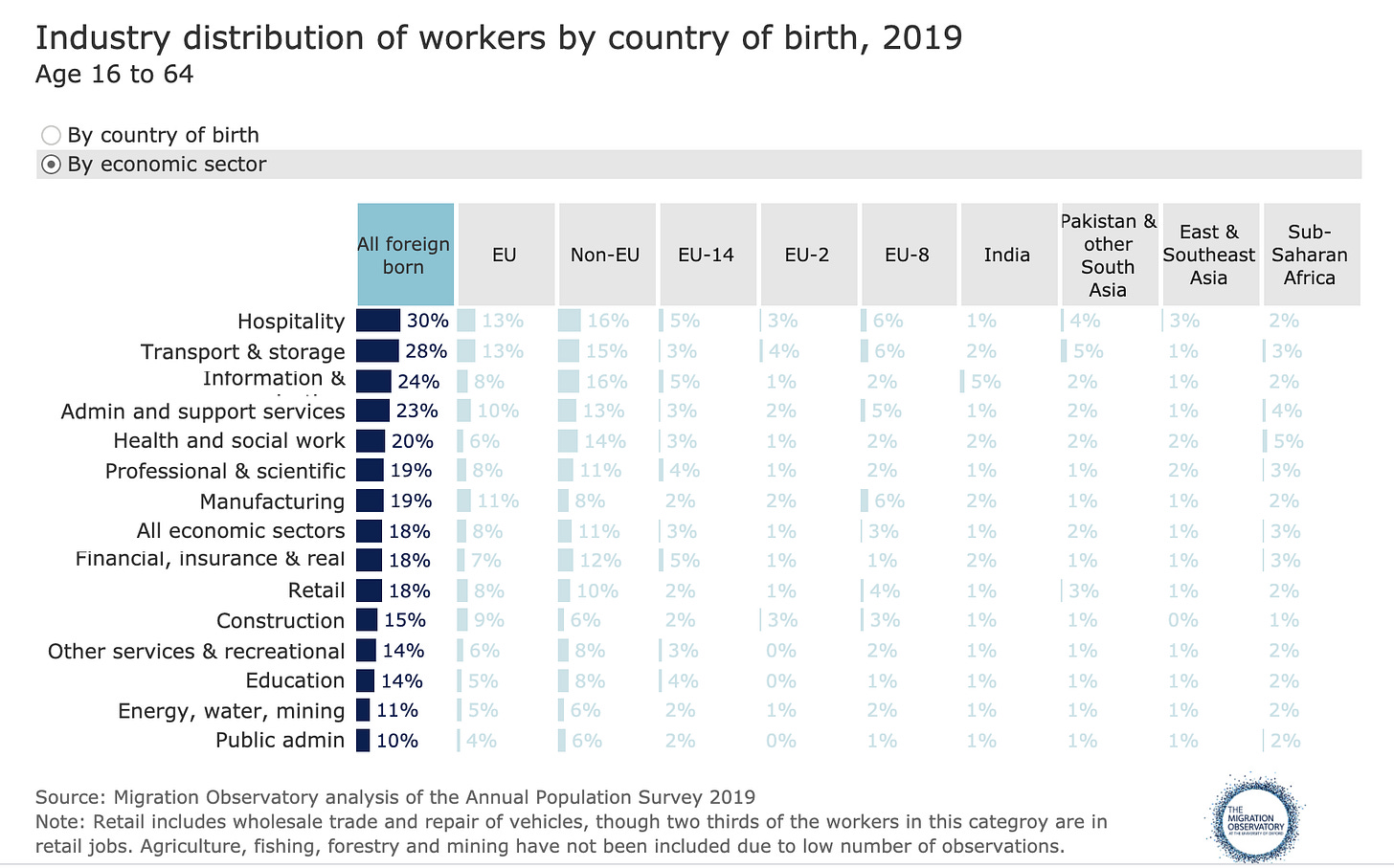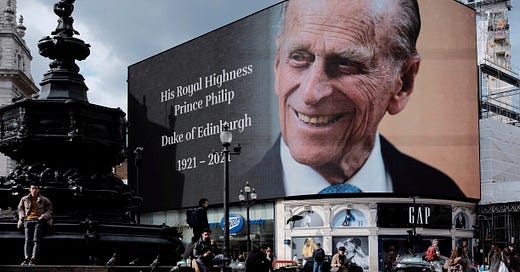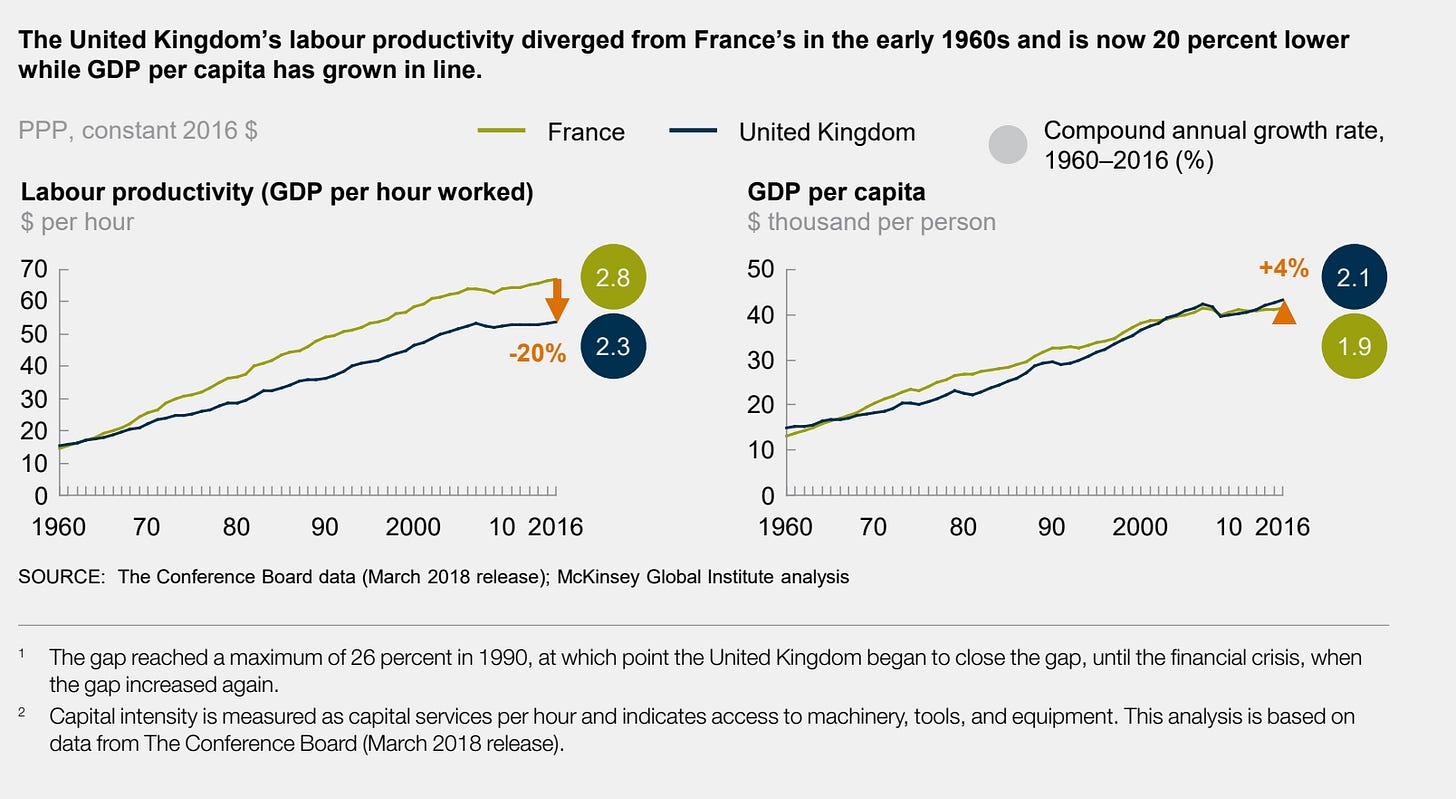What’s the deal with Britain? I will not pretend to be an expert on the British economy or the country’s politics. I’m more of an interested observer who takes advantage of a shared language to see how another large advanced economy is faring.
In some ways the United Kingdom is distinctive, in other ways, it’s experiencing trends that are quite similar to those being experienced in the United States and other wealthy democracies. This will be less a unified essay than a series of observations. I always ask for feedback and comments, but now more than ever I would appreciate any notes, corrections, or addenda either in the comments or at matthew.zeitlin@gmail.com
A service-oriented economy, especially for exports
While all modern national economies are, to some degree, service economies, the United Kingdom is a service economy in the extreme, with about four fifths of output and employment in the service sector. It ranks near the top of the OECD tables for value added from services.
It then ranks near the bottom in value added from manufacturing
The export mix is similarly oriented towards the service sector, with a persistent trade surplus in service and a trade deficit in goods.
A regionally unbalanced economy…
Perhaps the single biggest factor distorting the UK economy is the yawning inequality between its regions, or really between London and everywhere else. On nearly every metric besides, of course, housing costs, London outpaces the rest of the country. London is larger, more productive, wealthier, and growing faster.
…with substantial migrant labor
The low-wage service sector in Britain is substantially, or at least disproportionally, an employer of foreign born workers, from both Europe and further abroad. For workers in London servicing the high-end service sector that’s responsible for all the towers on Canary Wharf, this means very low real wages (wages adjusted for the cost of living) in the form of crowded, expensive housing that’s far away from the workplace.

With these real low wages and objectively difficult working and living conditions, it’s hard to find native Britons who want the jobs necessary to make London’s economy work. This is typically illustrated by way of the ubiquitous sandwich-and-coffee chain Pret and the dearth of job applications it gets from native Britons.
“Working class” voters increasingly vote for the right wing party
Stop me if you’ve heard this before: Older, less educated voters in regions that are facing economic decline and have traditionally voted for the left wing party are now powering gains for a conservative party that’s taken on a more nationalist hue.
It was precisely the presence of a large number of immigrants working in the types of jobs mentioned above (along with a conservative press devoted to their demonization) that helped spur the desire to leave the European Union and “take back control” of the British state — and its borders. The Conservative government is besotted with Canada and Australia’s migration systems that give preference to highly educated workers that work in high-paying jobs.
And, finally, the UK has poor productivity growth compared to its neighbors and other rich countries and its workers lag in hourly productivity to France. France!
So where exactly does Brexit fit into all of this?
With the picture(s) presented above, choosing to leave the European Union may seem like an odd choice. It’s an economic stumbling block that particularly endangers the services trade that may crack the fragile regional economic balance and labor markets. But when you put all these aspects of the British economy together, something like a unified picture emerges.
But there’s another way of looking at it. One can also squint at the economic landscape and see a way in which the government’s agenda of migration into higher-paid jobs, state aid, and regional assistance makes a certain kind of sense.
Some kind of regional rebalancing is a political and economic necessity for Boris Johnson’s government, as it must repay the reward of a whomping majority gifted by parts of the country that may have only lent him their vote.
That’s because the conservative stance towards migration could imperil the current economic structure of London, and thus the economy as a whole. If there’s a slowdown in migration of those willing to take low paying jobs on the other side of the coronavirus, the London economy will become even harder to keep together, along with what growth engine the not-very-productive British economy has.
The most optimistic take on the Conservative program of statue protection, migration re-allocation, aid to British enterprises, and investment in “left behind” regions is that an infusion of high-paying service jobs in other parts of the country could make low-wage work more attractive (and remunerative) while high-wage migrants could help boost productivity across sectors. British exports and manufacturing will be boosted by state aid and highly educated migrants, jump starting a more economically, regionally, and politically balanced economy.
But for this to work, it requires a level of seriousness and commitment that one has not traditionally associated with Johnson. “Leveling up” will require actually reducing the economic gaps between regions, not merely shoveling money to well connected Conservative donors in newly politically friendly constituencies. And making the financial services industry’s life more difficult by way of Brexit will not revive the North of England.
The industries that anchored these left behind regions — mining, shipping, etc — are not magically coming back now that the passports are blue. This puts immense pressure on either rebalancing existing economic structures to be more evenly spread out throughout the country or using a newly freed interventionist British state to create it out of cold, wet air.
Precisely by plunging the government into a few years of permanent crisis and then dramatically upping the stakes of its execution, Brexit could theoretically serve as a catalyst for a great recasting of Britain’s political economy. But if the Brexit vote was a complex three way bet between three right wing men for their political prospects in today’s Britain, then the way that bet gets paid out leaves a whole nation in the balance.














Probably not what you're looking for, but some comments on the stats:
France has pretty high productivity in terms of GDP per hour - higher than Germany depending on how you adjust it. Of course with a lower GDP per capita than the UK, this means fewer hours, hard to know exactly how to interpret this - are there any country-wide biases in hour measurements? Probably some. But if it's truly the case that France is becoming more per-hour productive and using that to just work less... Good trade. Some evidence is out showing sharp diminishing returns to hours worked, e.g. in here https://hbr.org/2015/08/the-research-is-clear-long-hours-backfire-for-people-and-for-companies If this is true, productivity growth may not really be that much slower in the UK, they're just working far too much (doesn't explain the US that well though)
For the education differences, at least in the US:
- The voting patterns of highschool non-college do change a bit over time: from just over 50% dem on average prior to 2016 to 45% dem in 2016. This is now a very big group!
- However, looking at the graph over time, it changes by far more than 5%. This is primarily driven by change at the top 10% and not as much the bottom 90%. The top 10% go from like under 40% dem in 1960 to over 70% dem in 2016
- a small part of what's happening is that the top 10% is a very different group over time. In 1976 for example most of this top 10% was people with BAs (negligible % with PhDs, 4% had masters, 11% had BAs), but in 2016 we had 2% with PhDs, 11% with MAs.
- The voting patterns of those without high school is sort of consistent over time, this group just goes from huge to small
I imagine something similar is happening in Britain - I guess these "10% of people vs 90%" in terms of voting behaviour within those groups is liable to produce weirdness. E.g. if it was balanced 50% dem in both bottom 90 and top, and then went to 48% dem in bottom 90%, the balancing % voting dem in top 10% to stay at 50% overall would be 68%, thus the gap between the groups would be 20%, even though the bottom 90% are mostly the exact same way.
I suppose my thought here is: if you care to evaluate the differences in voting behaviour of the working class, just measure that directly instead of subtracting it from a tiny weird subgroup.
You managed to articulate a logic to what seemed to me mostly madness. Who knows maybe they'll pull it off.